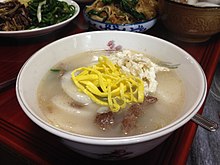Tteokguk
 |
|
| Alternative names | Sliced rice cake soup |
|---|---|
| Type | Guk |
| Place of origin | Korea |
| Main ingredients | Tteok |
| Other information | related to Korean New Year |
| |
|
| Korean name | |
| Hangul | 떡국 |
|---|---|
| Revised Romanization | tteokguk |
| McCune–Reischauer | ttŏkkuk |
| IPA | [t͈ʌk̚.k͈uk̚] |
Tteokguk (떡국) or sliced rice cake soup is a traditional Korean dish eaten during the celebration of the Korean New Year. The dish consists of the broth/soup (guk) with thinly sliced rice cakes (tteok - it can be called a kind of rice pasta). It is tradition to eat tteokguk on New Year's Day because it is believed to grant the consumer good luck for the year and gain a year of age. It is usually garnished with thin julienned cooked eggs, marinated meat, and gim.
The origin of eating tteokguk on New Year's Day is unknown. However, tteokguk is mentioned in the 19th century book of customs Dongguksesigi (동국세시기, 東國歲時記) as being made with beef or pheasant used as the main ingredient for the broth, and pepper added as seasoning. The book also mentions the custom of having a bowl of tteokguk in the morning of New Year's Day to get a year older, and the custom of saying "How many bowls of tteokguk have you eaten?" to ask a person's age.
In the book The Customs of Joseon written in 1946 by historian Choe Nam-seon, the New Year custom of eating tteokguk is speculated as being originated from ancient times. The white tteok signifying purity and cleanliness would be eaten as a ritual to start off the New Year for good fortune.
In Korea, on Lunar New Year's Day, a family performs ancestral rites by serving tteokguk to their ancestors during a joint meal. Although tteokguk is traditionally a seasonal dish, it is now eaten at all times of the year.
The broth is generally made by simmering the main protein (beef, chicken, pork, pheasant, seafood) in a ganjang seasoned stock. The stock is then strained to clarify the broth and long cylinder-shaped garaetteok are thin-sliced diagonally and boiled in the clear broth. Garnish is added before serving; the garnish may vary by region and personal taste, but usual staples are pan-fried julienned egg yolks and whites, gim and spring onions.A drizzle of sesame oil is common just prior to serving the teokguk.
...
Wikipedia
